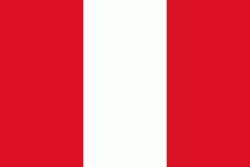Coropuna (Nevado Coropuna)
Coropuna is a dormant compound volcano located in the Andes mountains of southeast-central Peru. The upper reaches of Coropuna consist of several perennially snowbound conical summits, lending it the name Nevado Coropuna in Spanish. The complex extends over an area of 240 km2 and its highest summit reaches an altitude of 6377 m above sea level. This makes the Coropuna complex the third-highest of Peru. Its thick ice cap is the most extensive in Earth's tropical zone, with several outlet glaciers stretching out to lower altitudes. Below an elevation of 5000 m, there are various vegetation belts which include trees, peat bogs, grasses and also agricultural areas and pastures.
The Coropuna complex consists of several stratovolcanos. These are composed chiefly of ignimbrites and lava flows on a basement formed by Middle Miocene ignimbrites and lava flows. The Coropuna complex has been active for at least five million years, with the bulk of the current cone having been formed during the Quaternary. Coropuna has had two or three Holocene eruptions 2,100 ± 200 and either 1,100 ± 100 or 700 ± 200 years ago which generated lava flows, plus an additional eruption which may have taken place some 6,000 years ago. Current activity occurs exclusively in the form of hot springs.
Coropuna is located 150 km northwest of the city of Arequipa. People have lived on the slopes of Coropuna for millennia. The mountain was regarded as sacred by the Inca, and several archaeological sites have been discovered there, including the Inca sites of Maucallacta and Acchaymarca. The mountain was considered one of the most important Inca religious sites in their realm; human sacrifices were performed on its slopes, Coropuna forms part of many local legends and the mountain is worshiped to the present day.
The ice cap of Coropuna, which during the Last Glacial Maximum (LGM) had expanded to over 500 km2, has been in retreat since at least 1850. Estimates published in 2018 imply that the ice cap will persist until about 2120. The retreat of the Coropuna glaciers threatens the water supply of tens of thousands of people relying upon its watershed, and interaction between volcanic activity and glacial effects has generated mudflows that could be hazardous to surrounding populations. Because of this, the Peruvian geological agency, INGEMMET, monitors Coropuna and has published a hazard map for the volcano.
In Quechua, puna means "plateau", and coro is a common component of toponyms such as with Coro Coro, Bolivia, though its etymology is unclear. The name may mean Qoripuna, "Puna of Gold", "golden mountain", "cold, snowy" or "cut off at the top". The name is also spelled Qhuru Puna. The mountain is also called Nevado Coropuna; "Nevado" is the Spanish word for "snowy". There is another volcano in the Andahua volcanic field which has the same name, but is completely separate.
The Coropuna complex consists of several stratovolcanos. These are composed chiefly of ignimbrites and lava flows on a basement formed by Middle Miocene ignimbrites and lava flows. The Coropuna complex has been active for at least five million years, with the bulk of the current cone having been formed during the Quaternary. Coropuna has had two or three Holocene eruptions 2,100 ± 200 and either 1,100 ± 100 or 700 ± 200 years ago which generated lava flows, plus an additional eruption which may have taken place some 6,000 years ago. Current activity occurs exclusively in the form of hot springs.
Coropuna is located 150 km northwest of the city of Arequipa. People have lived on the slopes of Coropuna for millennia. The mountain was regarded as sacred by the Inca, and several archaeological sites have been discovered there, including the Inca sites of Maucallacta and Acchaymarca. The mountain was considered one of the most important Inca religious sites in their realm; human sacrifices were performed on its slopes, Coropuna forms part of many local legends and the mountain is worshiped to the present day.
The ice cap of Coropuna, which during the Last Glacial Maximum (LGM) had expanded to over 500 km2, has been in retreat since at least 1850. Estimates published in 2018 imply that the ice cap will persist until about 2120. The retreat of the Coropuna glaciers threatens the water supply of tens of thousands of people relying upon its watershed, and interaction between volcanic activity and glacial effects has generated mudflows that could be hazardous to surrounding populations. Because of this, the Peruvian geological agency, INGEMMET, monitors Coropuna and has published a hazard map for the volcano.
In Quechua, puna means "plateau", and coro is a common component of toponyms such as with Coro Coro, Bolivia, though its etymology is unclear. The name may mean Qoripuna, "Puna of Gold", "golden mountain", "cold, snowy" or "cut off at the top". The name is also spelled Qhuru Puna. The mountain is also called Nevado Coropuna; "Nevado" is the Spanish word for "snowy". There is another volcano in the Andahua volcanic field which has the same name, but is completely separate.
Map - Coropuna (Nevado Coropuna)
Map
Country - Peru
 |
 |
| Flag of Peru | |
Peruvian territory was home to several cultures during the ancient and medieval periods, and has one of the longest histories of civilization of any country, tracing its heritage back to the 10th millennium BCE. Notable pre-colonial cultures and civilizations include the Caral-Supe civilization (the earliest civilization in the Americas and considered one of the cradles of civilization), the Nazca culture, the Wari and Tiwanaku empires, the Kingdom of Cusco, and the Inca Empire, the largest known state in the pre-Columbian Americas.
Currency / Language
| ISO | Currency | Symbol | Significant figures |
|---|---|---|---|
| PEN | Peruvian sol | S/ | 2 |
| ISO | Language |
|---|---|
| AY | Aymara language |
| QU | Quechua language |
| ES | Spanish language |















